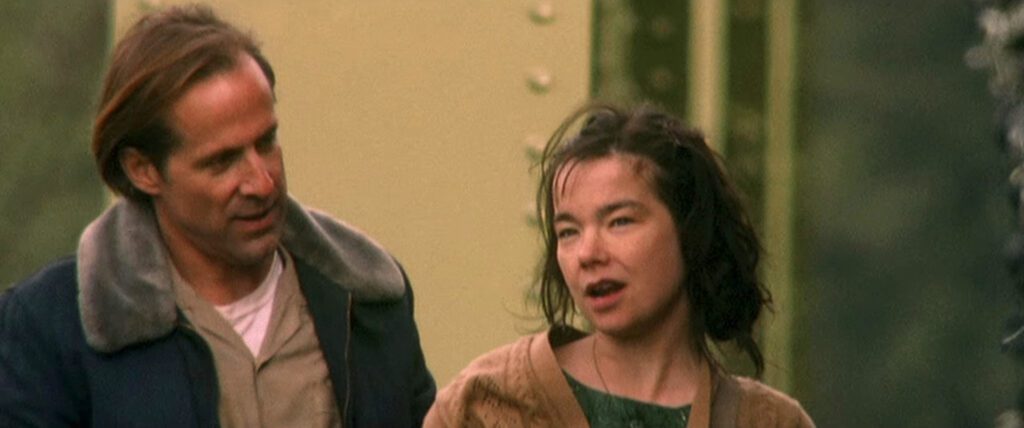
Dancer in the Dark
2000, directed by Lars von Trier
Film theorists like to say that a camera angle, or any other seemingly innocuous filmmaking decision, is an ideological statement. Nowhere is that better illustrated than in Dancer in the Dark. It’s hard to ignore the contrast between the film’s two divergent styles: the naturalistic hand-held cinematography influenced by Dogme 95, and the artificiality of the musical numbers influenced by classic Hollywood. The intention behind this contrast is absolutely specific. Taken together, the camera angles and other filmic elements here form a more compelling argument against the death penalty, and against the prevailing American ideology that allows that injustice, than any of the usual arguments typically thrown back and forth in political discourse.
The key to the argument is in the second excerpt from 42nd Street, the 1933 musical that Selma and Kathy watch in a local cinema. It’s one of those Busby Berkeley arranged scenes where the camera goes “out of the roof” as Selma says, to look down on a wedding cake formation of showgirls. The concentric rings of dancers, seen from directly above, look like a flower opening or a kaleidoscope turning, but there’s a fallacy in that kind of overhead shot. It purportedly takes place in a Broadway theater, where the audience would never appreciate the effect unless they climbed onto a catwalk above the stage. It’s a so-called “God’s eye view” staged in a fictional theater solely for a movie audience.
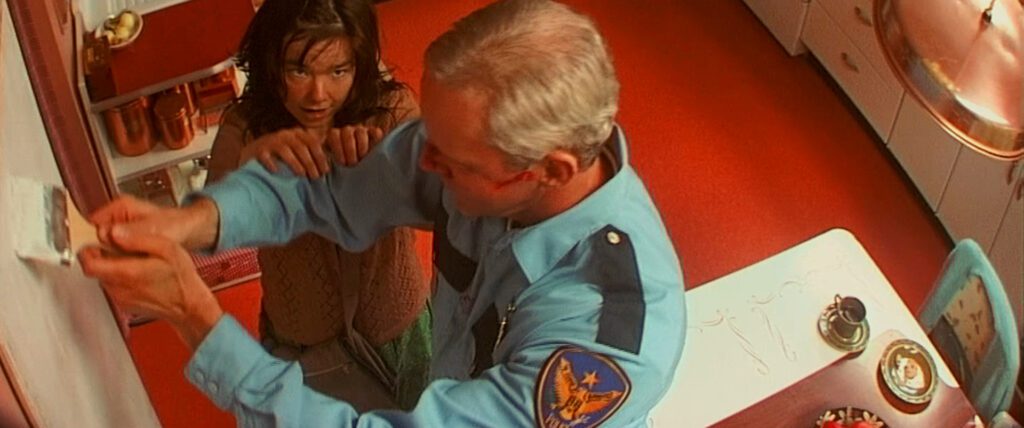
The camerawork in Dancer in the Dark never strays far from eye level until the characters start to sing and dance, whereupon the camera wanders freely in three or even four dimensions, looking up and down, allowing overhead shots that are akin to the wedding cake spectacles of Golden Age Hollywood. Through most of the film, a shaky hand-held camera simulates lifelike human vision, with sound, color, editing, and settings that adhere to a semblance of everyday reality, but the musical numbers break all the Dogme 95 rules. The picture is no longer lifelike – the camera and editing simulate a godlike perspective, seeing everything at once from above, around, and below.
This pervasive God’s eye view explains much of the musical scenes’ emotional power. For those few moments we see the world as if through the loving eyes of a God. The first musical number comes as a surprise, emerging about forty minutes in from the rhythms of the factory machines, an outpouring of joy in contrast to the joyless work environment. The fifth number, in the courtroom, brings Selma into harmony with her judges and accusers, again imagining a world that could be if only there were sufficient love. The sixth number shows Selma’s march to her execution, stopping to comfort other death row prisoners, bringing out the good in them too. We might see these fleeting moments as contrary-to-fact, but the reason they’re so affecting is that there’s a truth in them. The charitable perspective that puts everyone in a good light is so much broader than the narrow, petty, human point of view behind all the antagonism that drives the plot. We must also sense that Selma, unlike the characters around her, is already in tune with this broader “divine” vision, so that the musical scenes validate her joyous vision of life, even as she spirals into tragedy. Each musical number ends with a crushing blow – a machine accident, blindness, the arrival of police, Selma’s arrest, her verdict, her noose, and her death – so that pain and elation are held together in maximum tension. The power of Dancer in the Dark, and of its suggested God’s eye view, is that the elation of the song-and-dance numbers expresses a deeper reality than the wrenching drama around them.
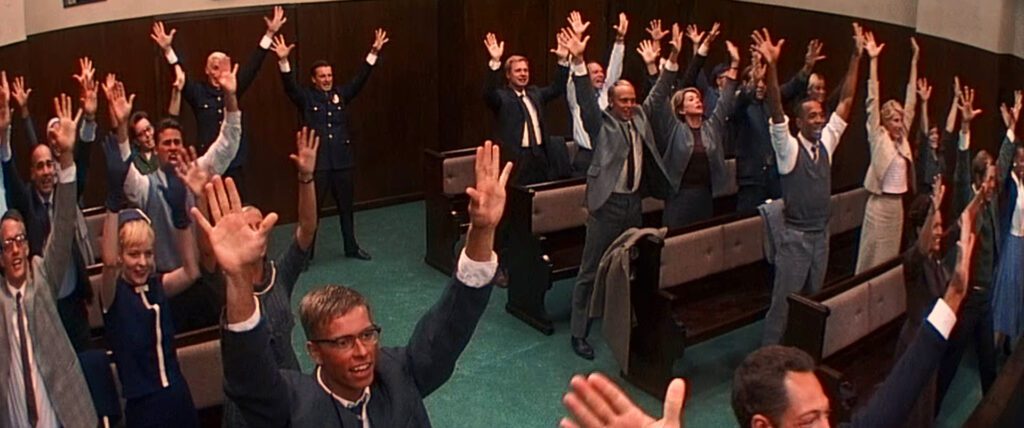
It’s one thing to imagine how a deity might look down on human beings, but it’s another thing to sit in judgment, presuming to know what others deserve. One is speculative, making no assertion of certainty; the other is what’s often called “playing God”. An argument against playing God rests on no religious claims; it simply asserts that absolute judgments of people and situations arrogantly assumes a point of view to which humans are not entitled. In most of Lars von Trier’s films there’s someone who plays God, usually with a moralistic pretense – think of the church elders in Breaking the Waves, the villagers in Dogville, Grace in Manderlay, Ravn and Kristoffer in The Boss of It All, or Seligman in Nymphomaniac. Their moral stance typically leads to atrocities. The problem isn’t that they’re not moral enough – it’s that moralism itself presumes superiority.
In Dancer in the Dark we find American society and its judicial system presuming a right to punish with the finality of death. Arguments against capital punishment that invoke deterrence or the possibility of innocence may be valid, but they don’t go to the root of the problem – that the death penalty is playing God. There is no way to apply it without overstepping the limits of the human situation. It presumes a moral superiority that we have no right to claim.
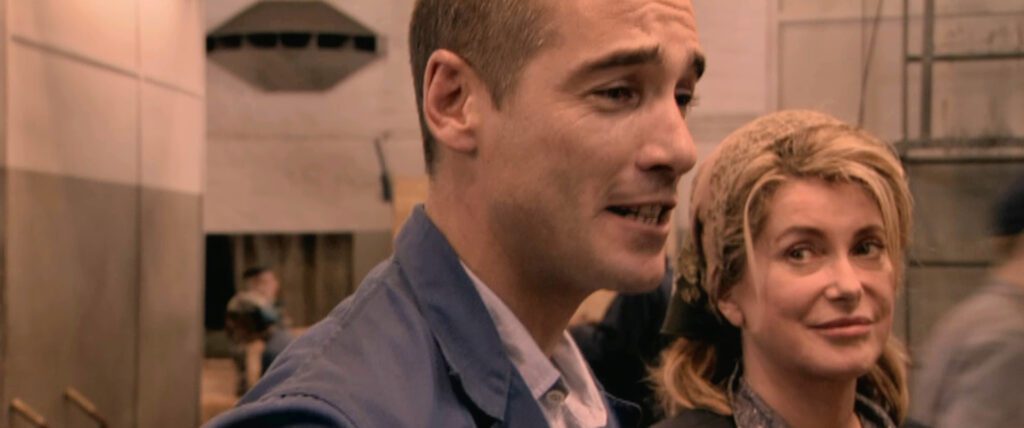
By the letter of the law Selma is guilty. She killed Bill Houston when she had the alternative not to. It’s only because the movie gives us her full perspective that we know she’s actually innocent, yet she hides her extenuating circumstances for reasons that the court can hardly imagine. If the court can condemn this young, white, unthreatening mother so easily, how much more might it fail when judging a black man, for instance? Selma’s name alludes to the famously brutal suppression of a 1965 civil rights march in Alabama, a reminder of the United States’ injustice toward African-Americans. As we see in the cell blocks toward the end, the death penalty in the United States is applied disproportionately to black males. It’s unfortunate but probably accurate that only a stereotypically sympathetic white character like Björk’s could effectively hold any hope of changing the minds that need to be persuaded.
Although Dancer in the Dark is shot mainly in Sweden by a Danish director, it’s set in the United States, the only developed Western country with the death penalty when the movie was made. The U.S. flag makes a pointed appearance right after Bill’s death when Selma’s fate is sealed, and the setting in the state of Washington is a shorthand for the country as a whole, which the name “Washington” represents. Lars von Trier continued his critique of the country in his following unfinished trilogy, beginning with Dogville, and whose abandoned third part was to be titled Washington. As Dogville makes clear, von Trier saw the United States as a country prone to playing God, both in its readiness to judge and in its actions on the world stage.
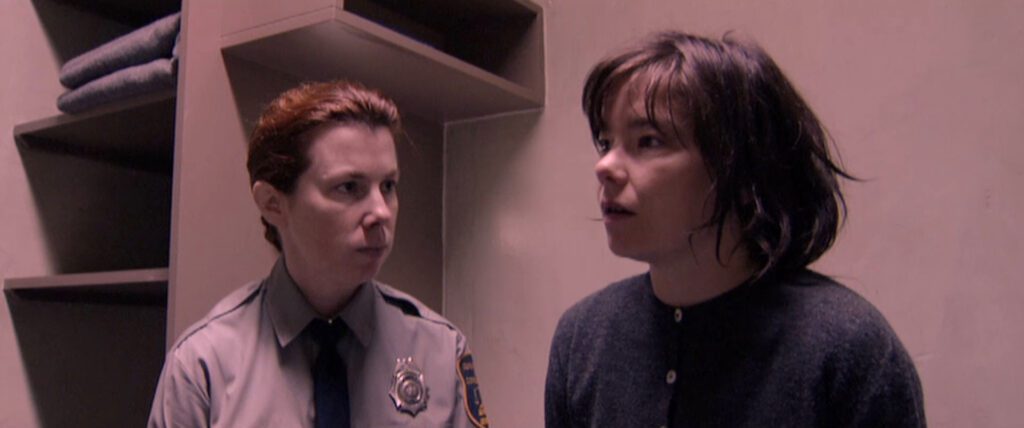
The musical prelude to Dancer in the Dark is a three-minute sequence of morphing abstract color formations. Its spotty compositions can be read as simulating Selma’s loss of vision, but by the same token it also represents the impaired vision of those who wish to play God. Their judgment impedes their social vision, dooming them to live in a joyless world. Selma’s vision is superior because she asserts no superiority. Although she’s a failure on the stage, in an amateur production of The Sound of Music, she holds an exceptional creative potential that develops across the seven musical numbers. In the first five her imagination depends on her environment – she can only create music if she’s given external sounds to work with, like a passing train or the courtroom artist’s pencil scratching on paper. In the sixth musical sequence, marching to the noose, the warmhearted prison guard Brenda tells her she’ll have to create her own rhythm, and her final song requires no prompt at all. On one level her experience has made her self-sufficient, but if we look at her as an artist, it’s significant that only at the moment of death does she achieve the godlike privilege of creating something from nothing.
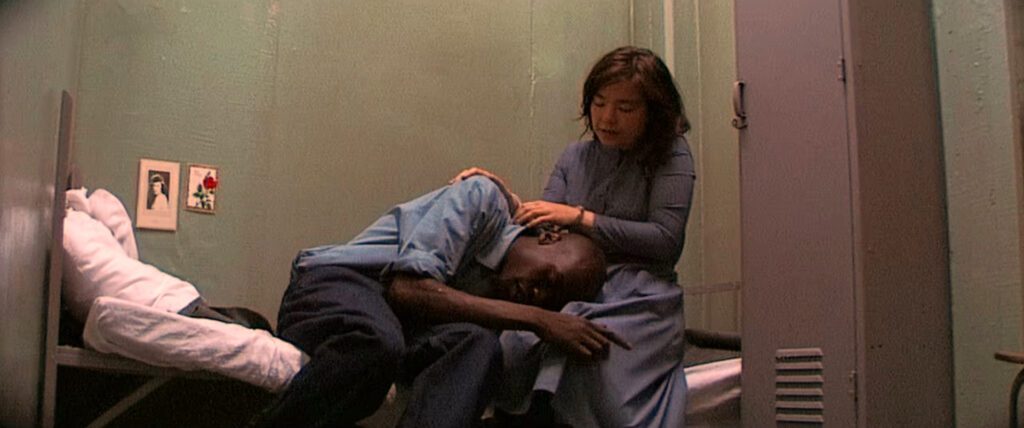
Selma tells Bill she hates it when the camera in a musical goes through the roof, not because of the God’s eye view but because it means the film is about to end. As a child she used to leave the cinema “just after the next to last song, and the film would just go on forever.” Her implicit criticism brings us obliquely back to the film’s point. Most movies, with their closed endings that resolve everything, play God after a fashion because they exclude alternate ways of experiencing their story. A closed ending tries to force a single perspective on the audience. If Selma had sought out movies with ambiguous endings, she could have watched to the end and still allowed the film to “go on forever”. Although the film ends with Selma’s “Next to Last Song” still ringing in our ears, her death would seem to give the film the finality of a closed ending. Dancer in the Dark gets around this in two ways. First, after Selma’s hanging, the camera starts to rise as if following her to heaven, but it quickly cuts to black (inverting the opening prelude that faded to white). The film declines to play God because it refuses to take us where the living cannot go. Second, and more importantly, by leaving us alone to face the injustice of our present world, the film asks us to carry the story forward into real life, to confront the injustices that result from humans playing God, armed with a better understanding of their origins. As the final inscription says:
“It’s only the last song / If we let it be.”
CONNECTIONS:
The Passion of Joan of Arc – Saintly character surrounded by judges and executed
City Lights – Saintly protagonist ignored and misunderstood by society; blindness as a metaphor; emotional ending
The Third Man – Overhead view as a God’s eye perspective
A Woman Is a Woman – Musical film made, at least allegedly, in the style of a naturalistic film movement (Neorealism or Dogme 95)
Les créatures – Movie starring Catherine Deneuve about the folly of playing God
Andrei Rublev – Protagonist’s road to creativity in seven parts
Breaking the Waves – Good woman condemned by a judgmental society; seven parts
Dogville – God’s-eye view; predisposition of Americans to playing God
The Boss of It All – Scene where characters talk over a movie; argument about playing God
Melancholia – Idea that creating something from nothing is a divine privilege not permitted to mortal artists